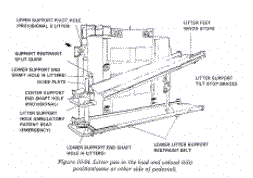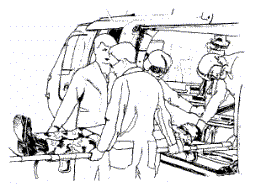UH-60 Blackhawk (Seahawk, Pave Hawk, Jayhawk)* |
| The UH-60 is a twin-engine, medium lift,
utility or assault helicopter, used by the Army, Navy, Air Force and Coast
Guard.
Some versions, such as the Air Force's MH-60 G Pave Hawk and the Coast Guard's HH-60J Jayhawk, are equipped with a rescue hoist with a 250 foot (75 meter) cable that has a 600 pound (270 kg) lift capability, and a retractable in-flight refueling probe. The Army's UH-60L Black Hawk can carry 11 soldiers or 2,600 pounds (1,170 kg) of cargo or sling load 9,000 pounds (4,050 kg) of cargo. The Army uses Blackhawks as the primary dedicated air ambulance. The typical medical evacuation configuration provides for four litter patients and one ambulatory patient. Other configurations include: (Each allows sufficient room for a crew chief and a medical aidman.)
When configured for medical evacuation for 4 litter patients, there is a center pedestal which can be rotated 90 degrees about the vertical axis to facilitate loading and unloading litters. Patients can be loaded from either side of the aircraft. The normal aircrew for medical evacuation missions numbers four, including a crew chief and medical aidman. Patients are positioned in the aircraft according to the directions of the aircrew:
|

|
||||||||||||||||||
*From Operational Medicine 2001, Health Care in Military Settings, NAVMED P-5139, May 1, 2001, Bureau of Medicine and Surgery, Department of the Navy, 2300 E Street NW, Washington, D.C., 20372-5300
Contents · Introduction · Learning Objectives · Textbook · Lectures · Procedures · Final Exam · Library · Laboratory · Pharmacy · Imaging · Forms · Videos · Search · About the Author · Contact Us
Military Obstetrics & Gynecology
© 2005
Medical Education Division,
Brookside Associates, Ltd.
All rights reserved


